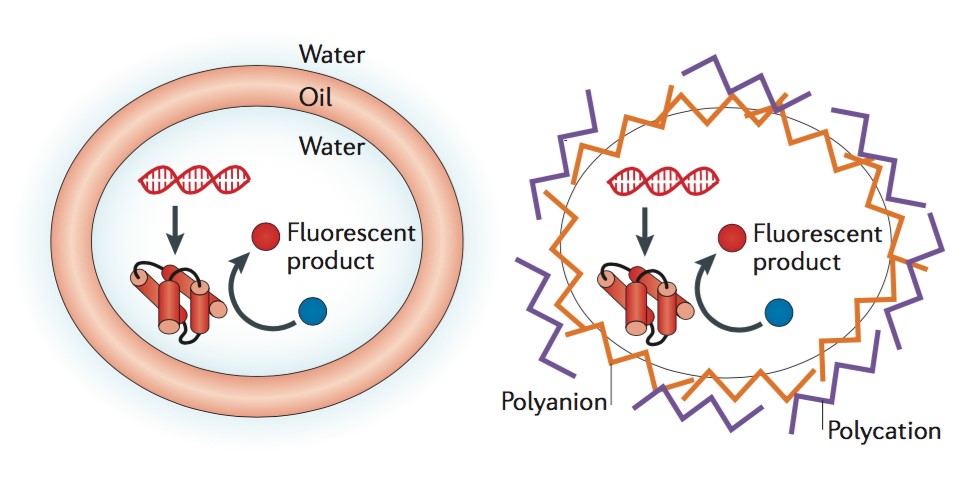Screening Artificial Cell-like Compartments
Based on the comprehensive protein evolution and engineering platform through years of experience, scientists from Creative Biostructure can provide advanced customized screening artificial cell-like compartments for directed evolution.
Creative Biostructure can perform high-throughput screening using in vitro compartmentalization (IVC). IVC is an alternative technique that uses the aqueous droplets in water-oil emulsions (up to 1010 compartments per ml) to compartmentalize individual genes and gene products along with a surrogate fluorogenic substrate. It is well-known that IVC method can enable protein evolution via two strategies, including emulsion of single cells expressing the library member and emulsion of individual DNA molecules together with in vitro transcription–translation machinery. In this method, flow cytometers can only sort particles in an aqueous mixture, while a secondary emulsion is necessary to create water-oil-water droplets for fluorescence-activated cell sorting (FACS)-based screening.
 Figure 1. Diagram of in vitro compartments, double emulsions of cell-like compartment (left panel) and polyelectrolyte shells (right panel). (Nature Reviews Genetics, 2015)
Figure 1. Diagram of in vitro compartments, double emulsions of cell-like compartment (left panel) and polyelectrolyte shells (right panel). (Nature Reviews Genetics, 2015)
Artificial cell-like compartments beyond water-oil emulsions can entrap genes, proteins and substrates in a suitable format for screening of directed evolution. Cell-like compartments composed of layered polycationic and polyanionic polymers (polyelectrolytes) can encapsulate E. coli cells. Due to the compartments are stable to detergents, DNA and protein remain linked even after detergent-induced cell lysis. Based on this technique, Creative Biostructure can screen for properly solubilized G protein-coupled receptors (GPCRs) that retain their structure and affinity for a fluorescent probe.
Artificial cell-like compartments have several advantages, including:
- Fluorescent gene product can be detected by FACS;
- Emulsion-based screening;
- High-throughput quantitative measurement-throughput limit is 107-108;
- Large library size;
However, the disadvantages of artificial cell-like compartments include IVC technique requires strong expertise; components for emulsion and polyelectrolyte shells must be optimized for compatibility with a given fluorogenic reporter; heavily geared towards evolution of enzymes with DNA substrates.
Additionally, Creative Biostructure can creative the solid platform for the development of artificial cell-like compartments based on cell-free expression system and liposome.
Creative Biostructure’s custom screening services can provide you a wide range of first-class strategies for directed evolution. Creative Biostructure also provides Membrane Protein Platform and Phage Display Platform for your specific projects. Please feel free to contact us for a detailed quote.
References:
F. Wu and C. Tan (2014). The engineering of artificial cellular nanosystems using synthetic biology approaches. WIREs Nanomed Nanobiotechnol. doi: 10.1002/wnan.1265
M. S. Packer and D. R. Liu (2015). Methods for the directed evolution of proteins. Nature Reviews Genetics, 16: 379-394.
W. C. Lua and A. D. Ellington (2013). In vitro selection of proteins via emulsion compartments. Methods, 60(1): 75-80.
